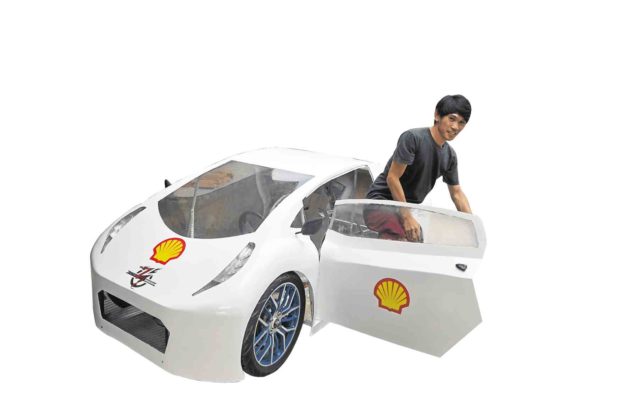
Ben Alfie Oliverio, a graduate student of mechanical engineering at MSU-IIT, is Tarintik’s official driver. —DIVINA SUSON
ILIGAN CITY — After months of planning, a team of engineering students from Mindanao State University-Iligan Institute of Technology (MSU-IIT) here has come up with a new look for Tarintik to compete in an international car design contest in Singapore next month.
The new car is no longer based on a shape of a raindrop as the Maranao name implied, but it still retains the aerodynamics of its former design, making it fuel-efficient, said Kister Jimenez, an instructor at MSU-IIT’s Department of Electrical Engineering and Technology and the faculty representative of the team.
Tarintik will compete in the urban concept category of the 2018 Shell Eco-marathon in Singapore on March 16-19 against vehicles with practical and energy-efficient designs.
It will be the third time for the team, who call themselves the Dagitab Dragons, to join an international car design competition.
The team fielded the first prototype of Tarintik in an international Shell marathon in Manila in 2015, despite the lack of sponsors. During the actual run, however, one of the parts of the gas-fed vehicle burst.
“They (students) fixed it on the runway,” Jimenez said. “When the team finally fixed it, the time was already up.”
Totally different
In 2016, the Dagitab Dragons joined another Shell ecomarathon in Manila but still did not make it.
This year, Jimenez said the team designed a totally different vehicle.
“Our first designs were like toy cars. These were three-wheeled. It was only now that we made a vehicle that has four wheels,” Jimenez said.
“The design of the car’s curves allows it to smoothly interact with the force of the wind,” he said. “The air would just flow around it, which means, less drag.”
Powered by a 650-watt lithium battery, the fiberglass-bodied Tarintik has been tested at a top speed of 40 kilometers per hour. During the actual run, however, the team will observe the 25-kph limit for safety.
“The vehicle’s design is road-worthy. It has hand and foot brakes, with signal, head and brake lights—just like normal cars. But this is better than the public utility jeepneys we see around,” Jimenez said.
Unlike jeepneys, he said, the car did not emit smoke.
But he recounted how difficult it was for them to make their new design a reality.
Finding sponsors
Producing the new Tarintik was a challenge for the team.
“We had difficulty finding sponsors,” Jimenez said. While it cost half of the first prototypes they produced, the electric vehicle was still not cheap at P100,000.
Jimenez said the team came up with the final design through a long process of trial and error.
While most parts of the engine were made from locally available resources, the motor controller was designed by the students themselves.
“It is our own design. We sent it to China for fabrication, and when it was shipped back here, we assembled it on our own,” Jimenez said.
“This proved that they (the MSU future engineers) can already make their own engine and vehicle based on their own design. They can already put their imagination to reality,” he said.
Last week, Tarintik was shipped to Singapore to join the contest. Jimenez and the team will fly to the city-state on March 6, thanks to local sponsors.
“We always wanted to win,” said Ben Alfie Oliverio, the team’s official driver. “But driving the car during the actual marathon would already be a success for us.”
“To see the vehicle running on the track would already be the height of a dream,” he added.